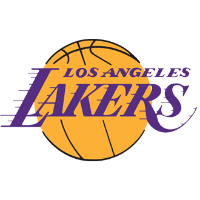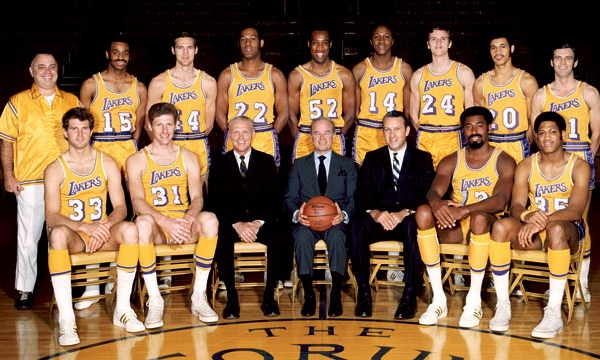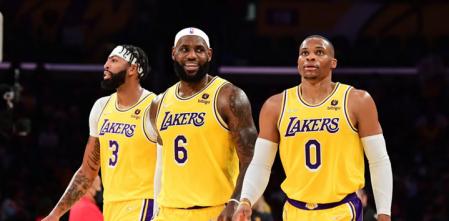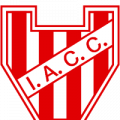
Los Angeles Lakers

1960 Los Ángeles
Los Angeles Lakers are a basketball team founded in 1946 that competes in the National Basketball Association (NBA), and belongs to the Pacific Division of the league. It has 17 championships and some of the best players in the history of basketball have played for the franchise, such as Magic Johnson, Kareem Abdul-Jabbar or Kobe Bryant.Los Angeles Lakers is undoubtedly one of the most important and successful teams in the NBA. Its beginnings date back to before being the Los Angeles Lakers, they were the Detroit Gems, and as the name indicated, they were located in that city and played in the National Basketball League, the NBA was not yet created.

Origins and early years
Although it may seem strange to us, the roots of the franchise are in Detroit. C.King Boring created a basketball team in the city called Detroit Gems, and after a bad season in the NBL, Boring decided to sell the team to two new owners. Bergen and Chalfner move the franchise to Minneapolis in 1947 and change the name to Minneapolis Lakers, due to the large number of lakes near the American city.
As the worst team by far in the entire competition in the previous season, the Lakers had the best pick in 1948 in a dispersal draft due to the demise of the Professional Basketball League of America (PBLA), another basketball parallel league. George Mikan was the chosen one, a 2.08 meters tall center who quickly became a tremendously dominant and almost infallible player with the hook. So much so that in that same season the Lakers managed to win the championship title, thanks in part to Mikan and two other great players like Pollard and Mikkelsen.
The following year, the franchise moved to the Basketball Association of America (BAA), where they also won the championship after showing a great superiority. Months later, the BAA and the NBL merged to create what we now know as the NBA, while the Lakers continued winning championships year after year until 1951, where they lost in the finals against the Rochester Royals.
That defeat did not dent the Minneapolis Lakers, who went on to win three rings in the following three championships. The first great NBA dynasty was thus established, winning five titles in six years (1949, 1950, 1952, 1952, 1953 and 1954). After this glorious era, Mikan's retirement left the effect of several seasons of poor results for the Minneapolis Lakers, until 1959, when the arrival of Elgin Baylor brought hope back to the franchise and managed to take the Lakers to the NBA Finals.
Relocation to Los Angeles
Despite having an All-Star like Baylor in the ranks of the franchise, the Minnesota fans turned their backs on the team after Mikan's retirement and attendance at the stadium dropped significantly. Because of this, the owners of the team decided in 1960 to move the franchise to the city of Los Angeles in order to be more competitive and attract more fans to each of their games.
The Los Angeles Lakers had a good team at that time with Baylor and a newcomer Jerry West as top stars, but every time they tried to reach the top they ran into the same rock again and again, Bill Russell's Celtics. Four lost finals in seven years against the team from the city of Boston, were the birth of one of the great rivalries that still persist to this day in the NBA. Celtics vs. Lakers.
The franchise needed another great player to accompany Baylor and West, and that is why Wilt Chamberlain arrived in Los Angeles in 1969 in search of that ring that the Boston Celtics took away from him every year. Already 32 years old, Wilt had just averaged 24.3 points, 23.8 rebounds and 8.6 assists the previous season, almost nothing. After easily defeating San Francisco and Atlanta, everything seemed to indicate that the Lakers could finally beat their bête noire. But after leading 2-0 in the Finals, the Boston Lakers managed to bring out their best game and come from behind to win the series 3-4.
The following year, the biggest stars of the team began to have problems with injuries, Baylor and Chamberlain had to undergo surgery and that reduced the competitive level of the franchise in the regular phase. Even with all this, they managed to reach the Finals again only to lose again 4-3, this time to the Knicks. This was not the end of the Lakers' bad luck, because in the following season they lost again in the last round to Kareem Abdul-Jabbar's Bucks.
Everything would change in the 1971-1972 season, without Elgin Baylor. Record of victories in regular phase at that time (69), and finally getting that long-awaited ring that was resisting in the city of Los Angeles, also beating their last two tormentors, Bucks and Knicks. West and Chamberlain played one more year before retiring, but despite still achieving great individual numbers, they were unable to win any more championships.
The arrival of Kareem
Lew Alcindor, later known as Kareem-Abdul Jabbar, arrived in California from the Milwaukee Bucks. Considered one of the greatest players of all time, the New York-born center dominated opposing teams with tremendous ease and created his own shot, 'Sky Hook', an almost impossible to block hook that marked a before and after in the league.
In his first year with the Lakers Kareem won his fourth NBA MVP, but could not lead the team to the championship, losing in the semifinals to Bill Walton's Blazers. In the following two seasons, 1977-1978 and 1978-1979, they couldn't get very far in the playoffs either, being eliminated by the Seattle Supersonics both seasons.
Blessed draft pick
NBA draft picks have marked the history of the Los Angeles Lakers with the arrival of great superstars, but the 1979 draft was to mark a before and after in the history of the franchise and basketball in general. Earvin Magic Johnson was chosen in the first position by the Californian team from Michigan State. The point guard would thus be reunited in the league with his great rival in college and Celtics player, Larry Bird. The rivalry was on.
That season ended with the championship ring for the Lakers, the sixth MVP for Kareem Abdul-Jabbar and the consecration of Magic in an anthological Finals against Julius Erving's Sixers, a star was born. A year later, an unexpected loss to the Houston Rockets in the first round of the playoffs led to the dismissal of Paul Westhead as head coach of the franchise.
With Pat Riley at the helm of the team, in 1982 the Lakers managed to win the NBA again with another excellent year from Magic Johnson and displaying a flashy, cheerful and fast game that dazzled the team's fans. In 1983 and 1984 the Los Angeles Lakers also played in the NBA Finals, but lost to the 76ers and Celtics respectively. It wasn't until the following year that the Los Angeles Lakers won the championship again in a rematch against the Boston franchise.
The second half of the decade was also profitable for the franchise in terms of success, reaching three Finals in four years and winning two more championships against the Celtics and the Detroit Bad Boys.
The end of a magical era
The loss in the 1989 Finals to the Detroit Pistons meant the end of a golden era for the Los Angeles franchise. Kareem announced his retirement at the age of 41 and although a young Vlade Divac seemed to make the legendary center forget, the Lakers were defeated by the Suns in the conference semifinals. This led to Riley's decision to leave the bench and be replaced by Mike Dunleavy.
The new coach was betting on a slower game than his predecessor, which led to a bad start for the team. But after that period of adaptation, the Lakers managed to reach again other NBA Finals, where they would fall hard against the Bulls of Michael Jordan and Phil Jackson.
The bad news kept coming to Los Angeles, but the hardest and most tragic of all was still to come. On November 7, 1991, Magic Johnson announced that he was a carrier of HIV and his decision to retire immediately. With this setback and the injuries of James Worthy and Sam Perkins, the Lakers lost competitive level and ended up succumbing in the first round of the playoffs against the Blazers.
After several seasons without great success, even missing the playoffs in 1993, Magic Johnson made a fleeting return to the court to try to help the Lakers, who seemed to have remained stuck in the past. The point guard contributed great things in the beginning of the season, although his performance diminished as the games went by. The franchise made it to the finals but were knocked out in the first round at the expense of the Houston Rockets. The owners of the Los Angeles Lakers could not seem to find the key to regain the success of the early 1980s.
O'Neal and Bryant: a duo for the ages
During the summer of 1996, the Lakers' management made two decisive moves for their history: Jerry West obtained the signing of Shaquille O'Neal from the Orlando Magic, and traded Divac in exchange for the rights to a young player named Kobe Bryant. The first three seasons were good in California, but year after year they fell in the playoffs against very strong teams at that time such as the Jazz of Karl Malone and John Stockton or the Spurs of the "twin towers", Duncan and Robinson.
The 1999-2000 season was different, with the turn of the century would also come the beginning of a new dynasty for the Los Angeles Lakers and a new pavilion to enjoy every night with the team, the Staples Center. O'Neal won the triple MVP crown (regular season, All-Star and NBA Finals) and the team from Los Angeles went ahead of the Kings, Suns, Blazers and Pacers to win a new ring, the first since 1988, and lay the foundations of a team that will remain in history.
For the following year the goal remained the same, to win the championship. A difficult regular season with injuries to players like Fisher, O'Neal or Kobe Bryant himself did not deprive the Lakers of winning their second consecutive division title. In the playoffs, the team was unstoppable. They reached the finals without losing a single game, and only lost once to Iverson's 76ers. The franchise won the back-to-back titles and Shaquille O'Neal was once again named MVP of the Finals.
The Lakers were the envy of every team in the league and the rival to beat. Meanwhile in California they started a new season winning 16 of the first 17 games of the campaign and reaching the All-Star break with a 33-13 record. Once again the franchise was unbeatable in the NBA Finals and beat Jason Kidd's New Jersey Nets on the fast track to the Finals. Three straight championships for a great generation of players led by two superstars and an unrepeatable coach like Phil Jackson.
Joy does not last forever, and although in 2002 Kobe Bryant had some of the best nights of his career, the Los Angeles Lakers failed to win their fourth consecutive title, losing in the conference semifinals to the dreaded San Antonio Spurs. After this minor failure, the decision was made to sign two veterans with hierarchy in Karl Malone and Gary Payton in the summer. The team started with a great winning streak, but injuries took their toll on important players as the season progressed, and Kobe and Shaq began to have friction on and off the court. The Lakers managed to reach the Finals again but succumbed in five games against the Detroit Pistons, thus came the beginning of the end for a team that seemed to have no ceiling.
After this, Jackson left the franchise's bench and Shaquille O'Neal was traded to the Miami Heat in exchange for Lamar Odom, Caron Butler and Brian Grant. The team started with a positive record and fought until the final stretch of the season for the playoffs, but injuries to Odom and Bryant weighed the team down and they finished with a 34-48 record.
Jackson returned to the helm the following season and the excitement returned to the Staples Center stands. Andrew Bynum came to the team through the draft and the likes of Kwame Brown were also signed. Kobe Bryant made history on January 22, 2006 by scoring 81 points against the Toronto Raptors, second only to Wilt Chamberlain and his legendary 100 points. The Lakers made it to the title playoffs, but could not overcome Steve Nash's Phoenix Suns in the first round. History would repeat itself a year later, when the Arizona Suns once again knocked them out of the championship game.
Kobe and Pau, Pau and Kobe
The 2007-2008 season began in a very positive way for the Los Angeles Lakers with a stellar Bynum and placing themselves for a time as conference leaders. The center was seriously injured in January and the franchise had to resort to the market to fill that important absence, so on February 1, Pau Gasol's arrival in Los Angeles was made official in exchange for several players and two draft rounds.
The Lakers managed to finish the regular season as first in the West and made it clear that they were once again a formidable opponent. In the playoffs, the Lakers overcame the Denver Nuggets, Utah Jazz and San Antonio Spurs to face the Celtics in the grand finale. Another battle in a war that came from the past. Boston managed to win the ring in six games, but in the heart of the Angelina franchise they knew they were back to aspire to everything.
The following year, the Lakers had a sensational season and won their 15th NBA championship by defeating the Orlando Magic 4-1. Kobe Bryant and Pau Gasol's good harmony on and off the court translated into success and victories for the franchise.
The 2009-2010 season was another spectacular campaign, achieving 57 wins in the regular season and with new faces on the team such as forward Ron Artest. As it could not be otherwise, the Lakers were again in the Finals, and this time with a taste of revenge. The Boston Celtics were the last hurdle to repeat as champions and continue to make it clear who was in charge in the NBA. The series was one of the best and most evenly matched in recent memory, especially an exciting and tough Game 7. The purple and gold managed to win the game and their sixteenth NBA championship.
Phil Jackson would announce the following year that this would be his last season as basketball coach. The team was once again one of the favorites throughout the regular season, but in the playoffs the Dallas Mavericks swept the Lakers 4-0. With Kobe Bryant hobbled by injuries, the California franchise only managed to make the playoffs in one of the next three seasons, finishing second to last in the Western Conference on two occasions.
A failed transition
In 2016 Kobe Bryant retired as a professional basketball player, leaving an indelible mark in the stands of the Staples Center and throughout the NBA. Considered one of the best players in all of history and about the piece that orbited the entire franchise in this 21st century. The name of the Los Angeles Lakers and Kobe Bryant will always go together.
Thus began a new era for the Lakers. A total reconstruction based on the young talents that arrived via the draft. Many names passed through the team's ranks during two seasons without the prize of playoffs: Lonzo Ball, Brandom Ingram, Jordan Clarkson or Kyle Kuzma are some of the players who sought to fill the void produced by 'The Mamba'.
The king comes to California
After the failure of that transition, the Lakers owners decide to go all in to try to regain the reign of the league. In 2018, one of the bombshells of recent times in the NBA becomes official, LeBron James signs for the Los Angeles Lakers with the intention of building a great winning project around him.
The 2018-2019 season did not go as expected, due in part to several injuries that left Lebron James off the court longer than desired. The team was again left out of the playoffs for the title and with a very bittersweet feeling after all the hopes deposited. After this, Anthony Davis joined the project for the next season with the goal of tucking James with another superstar of the league, thus becoming one of the top favorites for the ring.
The home of the Lakers
Currently, the Los Angeles Lakers share a home court with the Clippers at the Staples Center, however, due to the multiple changes the team has undergone throughout its history they have used around six pavilions:
Minneapolis Auditorium from 1948 to 1960, Minneapolis Armory 1959 to 1960, due to problems with the scheduling of the building they also shared the St. Paul Auditorium for several years.
From 1960 to 1967 they played at the Los Angeles Memorial Sports Arena and from 1967 to 1999 at The Forum. From that year to the present they have played at the Staples Center, one of the most modern and luxurious arenas, owned by the private sector and valued at 375 million dollars, named after one of its sponsors. In addition to basketball, it also hosts field hockey games and has a capacity of almost 20,000 people.
-3.jpg)
Historical players
Jerry West
Jerome Alan "Jerry" West was born on May 28, 1938 in Chelyan Virginia. He excelled in the Los Angeles Lakers and also served as a coach and executive. Hailing from West Virginia University, he played 14 seasons with the Lakers, with whom he was champion in 1972. He also won the gold medal at the 1960 Rome Olympics. He has been a Hall of Famer since 1980 and is the silhouette of the NBA logo.
Wilt Chamberlain
He was born in Philadelphia on October 21, 1936 and died on October 12, 1999. He was named MVP four times by the NBA. He played for the Lakers from 1968 to 1973, until he retired. Chamberlain holds the most NBA all-time records, with more than 70, many of them followed by records of his own.
The team also has had 26 Hall of Famers and have retired 11 different jersey numbers. Including 8 & 24, both wore by Kobe Bryant.
Kobe Bryant
Born in Pennsylvania on August 23, 1978, and died on January 26, 2020, Kobe Bryant played for 20 seasons in the NBA, always wearing the Lakers jersey. He is considered one of the best players in NBA history. Winner of five rings with the Los Angeles Lakers and two Olympic gold medals with the United States. He was an All Star on 18 occasions, and is undoubtedly one of the stalwarts of the team and of basketball in recent times.
-3.jpg)
Magic Johnson
Earvin Johnson, better known as 'The Magic', was born in Michigan on August 14, 1959 and is considered one of the best basketball players in history. He played for the Lakers from 1971 to 1999 where he won the championship five times, playing in nine Finals. He also won three times the Finals MVP and MVP of the seasons, and twice the MVO of the All Star Game.
Kareem Abdul Jabbar
Born in New York on April 16, 1947. Played for the Lakers from 1975 to 1889 where he won five championships. He retired as the leading scorer, shot stopper, defensive rebounder and the player with the most games and minutes played in the NBA.
Championships: 16 (1949, 1950, 1952, 1953, 1954, 1972, 1980, 1982, 1985, 1987, 1988, 2000, 2001, 2002, 2009, 2010)
Conference titles: 31 (1949, 1950, 1952, 1953, 1954, 1959, 1962, 1963, 1965, 1966, 1968, 1969, 1970, 1972, 1973, 1980, 1982, 1983, 1984, 1985, 1987, 1988, 1989, 1991, 2000, 2001, 2002, 2004, 2008, 2009, 2010)
Division titles: 23 (1971, 1972, 1973, 1974, 1977, 1980, 1982, 1983, 1984, 1985, 1986, 1987, 1988, 1989, 1990, 2000, 2001, 2004, 2008, 2009, 2010, 2011, 2012)







































